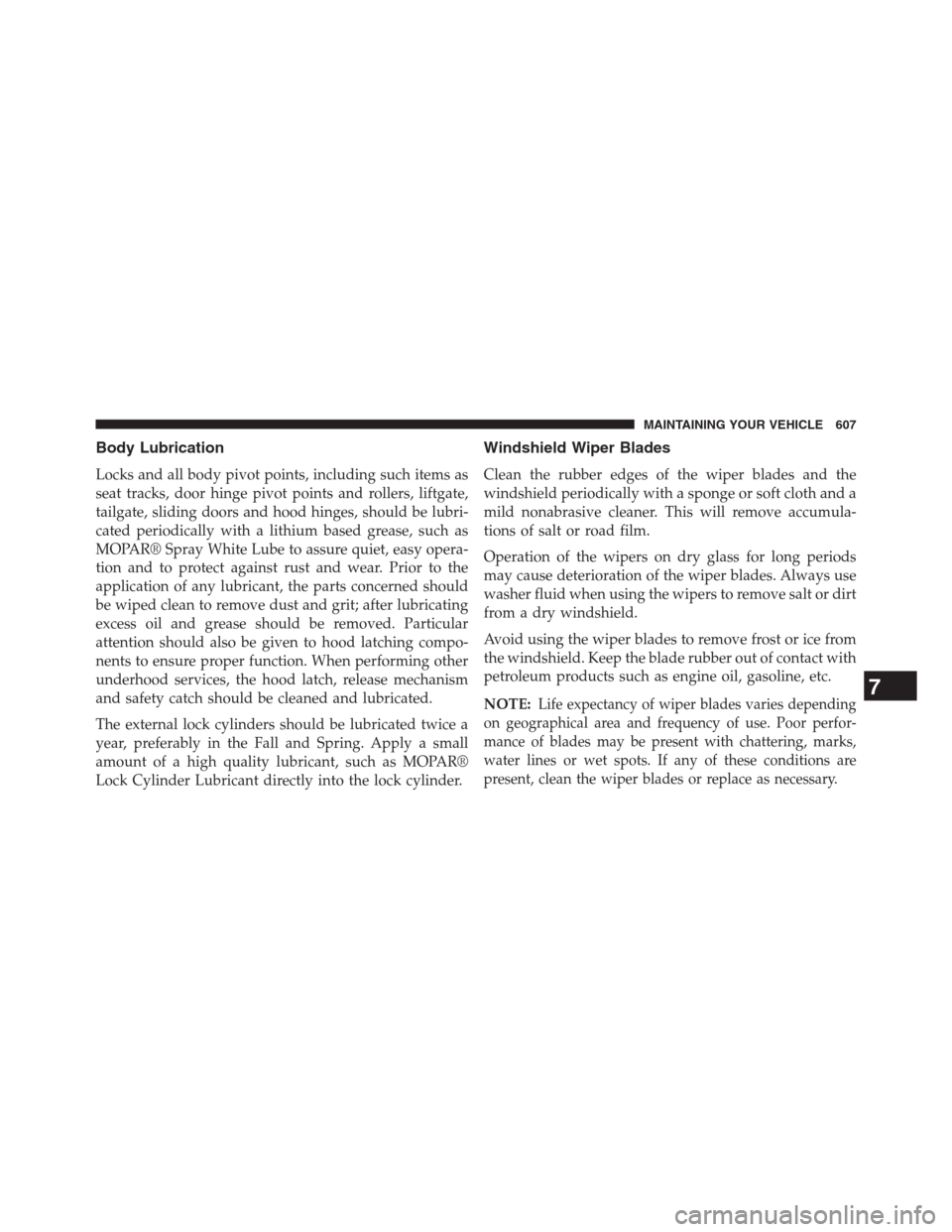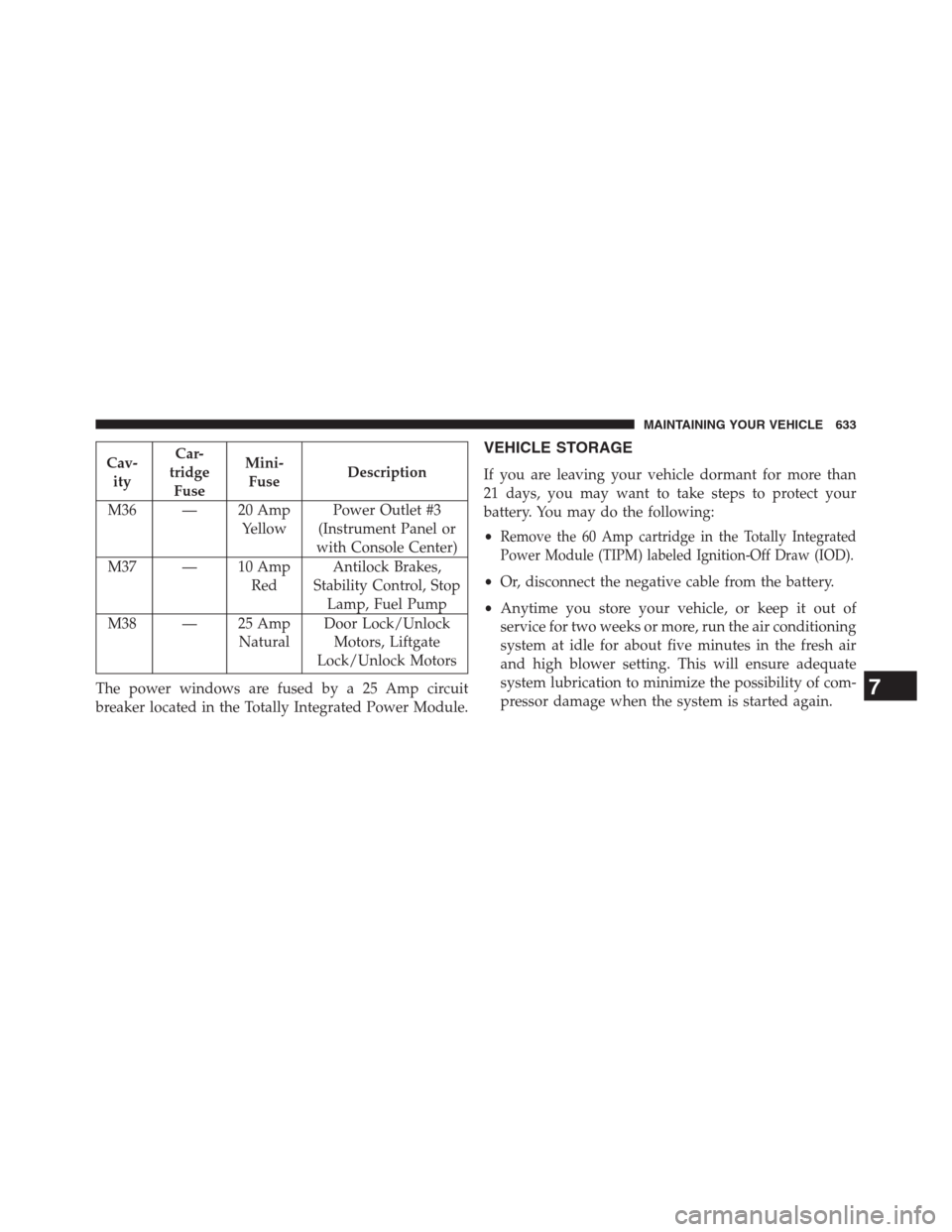Page 609 of 683

Body Lubrication
Locks and all body pivot points, including such items as
seat tracks, door hinge pivot points and rollers, liftgate,
tailgate, sliding doors and hood hinges, should be lubri-
cated periodically with a lithium based grease, such as
MOPAR® Spray White Lube to assure quiet, easy opera-
tion and to protect against rust and wear. Prior to the
application of any lubricant, the parts concerned should
be wiped clean to remove dust and grit; after lubricating
excess oil and grease should be removed. Particular
attention should also be given to hood latching compo-
nents to ensure proper function. When performing other
underhood services, the hood latch, release mechanism
and safety catch should be cleaned and lubricated.
The external lock cylinders should be lubricated twice a
year, preferably in the Fall and Spring. Apply a small
amount of a high quality lubricant, such as MOPAR®
Lock Cylinder Lubricant directly into the lock cylinder.
Windshield Wiper Blades
Clean the rubber edges of the wiper blades and the
windshield periodically with a sponge or soft cloth and a
mild nonabrasive cleaner. This will remove accumula-
tions of salt or road film.
Operation of the wipers on dry glass for long periods
may cause deterioration of the wiper blades. Always use
washer fluid when using the wipers to remove salt or dirt
from a dry windshield.
Avoid using the wiper blades to remove frost or ice from
the windshield. Keep the blade rubber out of contact with
petroleum products such as engine oil, gasoline, etc.
NOTE:
Life expectancy of wiper blades varies depending
on geographical area and frequency of use. Poor perfor-
mance of blades may be present with chattering, marks,
water lines or wet spots. If any of these conditions are
present, clean the wiper blades or replace as necessary.7
MAINTAINING YOUR VEHICLE 607
Page 629 of 683
CAUTION!
•When installing the Totally Integrated Power Mod-
ule cover, it is important to ensure the cover is
properly positioned and fully latched. Failure to do
so may allow water to get into the Integrated Power
Module, and possibly result in a electrical system
failure.
•When replacing a blown fuse, it is important to use
only a fuse having the correct amperage rating. The
use of a fuse with a rating other than indicated may
result in a dangerous electrical system overload. If
a properly rated fuse continues to blow, it indicates
a problem in the circuit that must be corrected.The numbers inside the TIPM cover correspond to the
following table.
Cav-
ityCar-
tridge
FuseMini-
FuseDescription
J1 40 Amp
Green— Power Folding Seat
J2 30 Amp
Pink—
Power Liftgate Module
J3 30 Amp
Pink— Rear Door Module
J4 25 Amp
Natural— Driver Door Node
J5 25 Amp
Natural— Passenger Door Node
J6 40 Amp
Green— Antilock Brakes
Pump/Stability
Control System
7
MAINTAINING YOUR VEHICLE 627
Page 630 of 683
Cav-
ityCar-
tridge
FuseMini-
FuseDescription
J7 30 Amp
Pink— Antilock Brakes
Valve/Stability
Control System
J8 40 Amp
Green— Power Memory
Seat – If Equipped
J9 40 Amp
Green— Partial Zero Emissions
Vehicle Motor/Flex
Fuel – If Equipped
J10 30 Amp
Pink— Headlamp Wash/
Manifold Tuning
Valve – If Equipped
J11 30 Amp
Pink— Power Sliding Door
Module/Anti–Theft
Module – If EquippedCav-
ityCar-
tridge
FuseMini-
FuseDescription
J12 30 Amp
PinkHVAC Rear Blower,
Radiator Fan Motor
J13 60 Amp
Yellow— Ignition Off Draw
(IOD) – Main
J14 40 Amp
Green—
Rear Window Defogger
J15 40 Amp
Green— Front Blower
J17 40 Amp
Green— Starter Solenoid
J18 20 Amp
Blue— Powertrain Control
Module Trans Range
J19 60 Amp
Yellow— Radiator Fan
628 MAINTAINING YOUR VEHICLE
Page 631 of 683
Cav-
ityCar-
tridge
FuseMini-
FuseDescription
J20 30 Amp
Pink— Front Wiper LO/HI
J21 20 Amp
Blue— Front/Rear Washer
J22 25 Amp
Natural— Sunroof Module
M1 — 15 Amp
BlueRear Center Brake
Lamp/Brake Switch
M2 — 20 Amp
YellowFront Fog Lamps
M3 — 20 Amp
YellowFront/Rear Axle
Locker, Vacuum Pump
Motor
M4 — 10 Amp
RedTrailer TowCav-
ityCar-
tridge
FuseMini-
FuseDescription
M5 — 25 Amp
NaturalInverter
M6 — 20 Amp
YellowPower Outlet #1
(ACC), Rain Sensor,
Cigar Lighter (Instru-
ment Panel or with
Console Rear)
M7 — 20 Amp
YellowPower Outlet #2
(BATT/ACC SELECT)
– Center Seat or with
Console Rear
M8 — 20 Amp
YellowFront Heated Seat – If
Equipped
M9 — 20 Amp
YellowRear Heated Seat – If
Equipped
7
MAINTAINING YOUR VEHICLE 629
Page 632 of 683
Cav-
ityCar-
tridge
FuseMini-
FuseDescription
M10 — 15 Amp
BlueIgnition Off Draw —
Video System, Satellite
Radio, DVD, Hands-
Free Module, Univer-
sal Garage Door
Opener, Vanity Lamp,
Streaming Video Mod-
ule – If Equipped
M11 — 10 Amp
RedClimate Control
System
M12 — 30 Amp
GreenAmplifier/RadioCav-
ityCar-
tridge
FuseMini-
FuseDescription
M13 — 20 Amp
YellowInstrument Cluster,
SIREN, Clock Module,
Multi-Function
Control Switch – If
Equipped
M14 — 20 Amp
YellowTrailer Tow – If
Equipped
M15 — 20 Amp
YellowRear View Mirror,
Instrument Cluster,
Multi-Function
Control Switch, Tire
Pressure Monitor,
Glow Plug Module –
If Equipped
630 MAINTAINING YOUR VEHICLE
Page 635 of 683

Cav-
ityCar-
tridge
FuseMini-
FuseDescription
M36 — 20 Amp
YellowPower Outlet #3
(Instrument Panel or
with Console Center)
M37 — 10 Amp
RedAntilock Brakes,
Stability Control, Stop
Lamp, Fuel Pump
M38 — 25 Amp
NaturalDoor Lock/Unlock
Motors, Liftgate
Lock/Unlock Motors
The power windows are fused by a 25 Amp circuit
breaker located in the Totally Integrated Power Module.VEHICLE STORAGE
If you are leaving your vehicle dormant for more than
21 days, you may want to take steps to protect your
battery. You may do the following:
•
Remove the 60 Amp cartridge in the Totally Integrated
Power Module (TIPM) labeled Ignition-Off Draw (IOD).
•Or, disconnect the negative cable from the battery.
•Anytime you store your vehicle, or keep it out of
service for two weeks or more, run the air conditioning
system at idle for about five minutes in the fresh air
and high blower setting. This will ensure adequate
system lubrication to minimize the possibility of com-
pressor damage when the system is started again.
7
MAINTAINING YOUR VEHICLE 633
Page 637 of 683
BULB REPLACEMENT
Headlamps
1. Raise the hood to access the rear of the headlamp
housing.
2.
Slide the red lock tab rearward on the connector, then
depress the tab and remove the connector from the bulb.
3. Twist the headlamp bulb and pull the bulb from the
headlamp housing.
4. Install the new headlamp bulb and twist until locked
into the headlamp housing.
CAUTION!
Do not touch the new bulb with your fingers. Oil
contamination will severely shorten bulb life. If the
bulb comes in contact with an oily surface, clean the
bulb with rubbing alcohol.
5. Connect the wiring connector to bulb and slide red
lock tab forward.
Front Park/Turn Signal Lamps
1. Raise the hood to access the rear of the headlamp
housing.
2. Twist the turn signal socket and remove from the
headlamp housing, then pull the bulb out.
3. Push the new bulb into the socket and reinstall the
socket by twisting until locked into the headlamp
housing.
7
MAINTAINING YOUR VEHICLE 635
Page 638 of 683

Fog Lamps
NOTE:Access to the fog lamp bulb is from the rear of
the fascia. On the left rear side of the fascia, remove the
push pin and lower the hinged access door on the air
dam.
1. From behind the bumper fascia, or the access panel on
the air dam, squeeze the two tabs on the side of the
bulb socket and pull straight out from the fog lamp.
CAUTION!
Do not touch the new bulb with your fingers. Oil
contamination will severely shorten bulb life. If the
bulb comes in contact with an oily surface, clean the
bulb with rubbing alcohol.2. Disconnect the wire harness from the bulb.
3. Reconnect the wiring harness to the new bulb and
reinstall by inserting the new bulb straight into the fog
lamp until it locks into place.
Rear Tail, Stop, Turn Signal, Side Marker And
Backup Lamps
1. Raise the liftgate.
2. Remove the tail lamp assembly by removing the two
screws from the inboard side. Use a fiber stick or
similar tool to gently pry the light on the outboard side
to disengage the two ball studs.
636 MAINTAINING YOUR VEHICLE